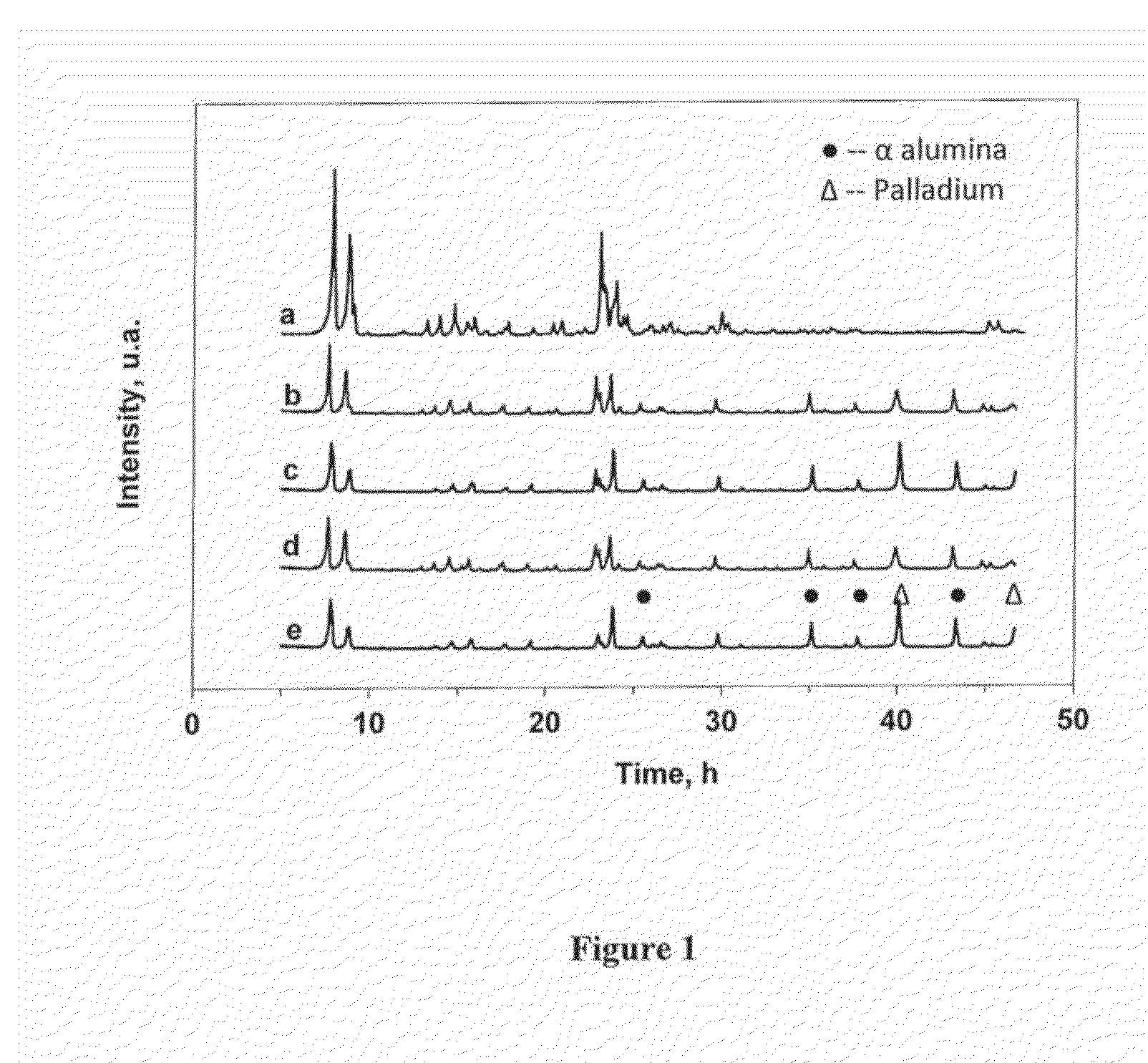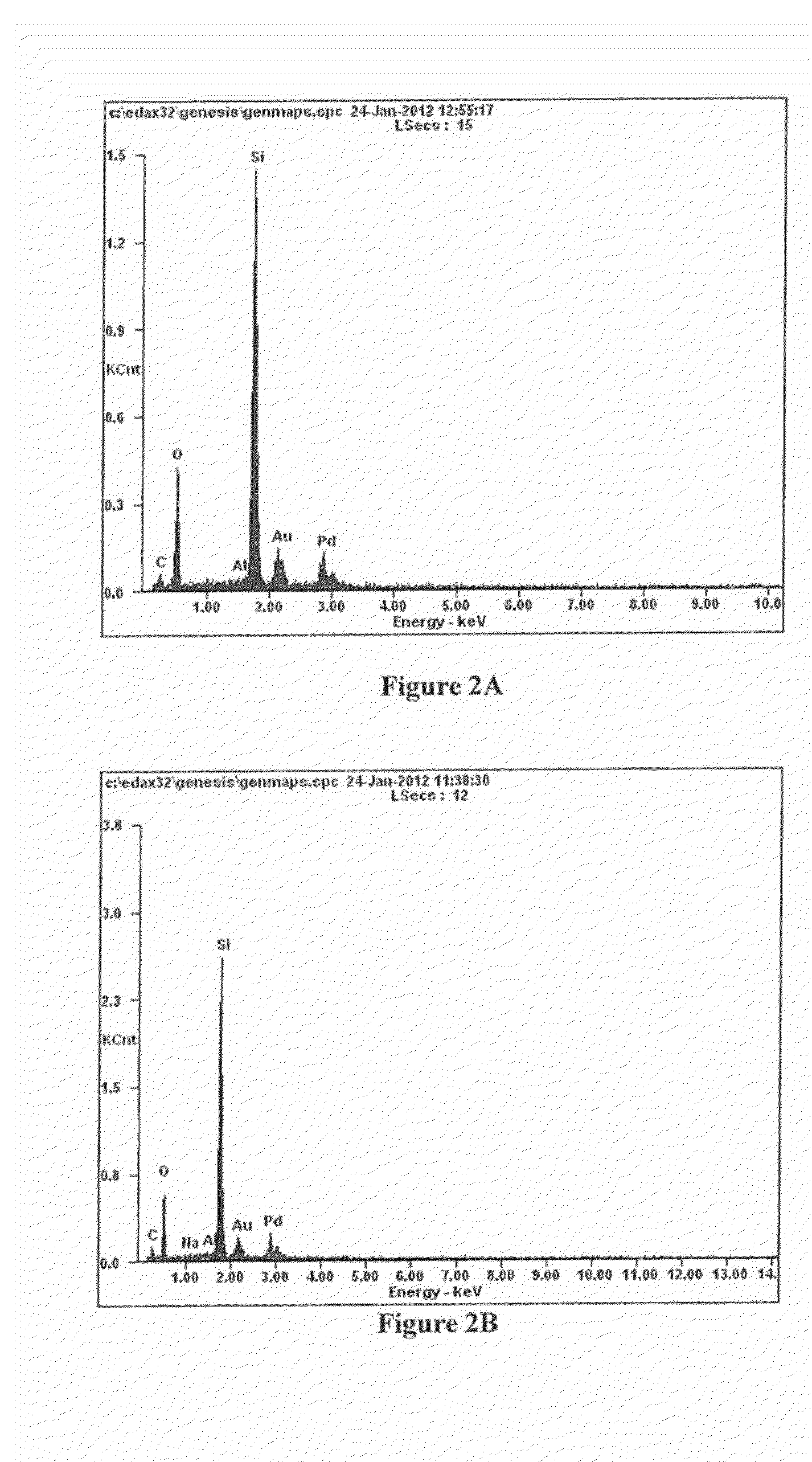Metal doped zeolite membrane for gas separation
a zeolite membrane and metal doped technology, applied in the field of zeolite membranes, can solve the problems of affecting the zeolites with low si/al ratios in the framework are generally not suitable for high temperature moist atmosphere applications, and the substrate properties are affected, etc., to achieve excellent hydrothermal and chemical stability, high selectivity and flux, and the effect of improving the quality of the membran
- Summary
- Abstract
- Description
- Claims
- Application Information
AI Technical Summary
Benefits of technology
Problems solved by technology
Method used
Image
Examples
example a
[0091]Silicalite (MFI structure) zeolite membrane preparation by in-situ method:
[0092]A precursor was prepared by mixing 0.35 g NaOH, 5 g SiO2, and 25 ml TPAOH (1M) at 80° C. in a water hath to form a clear solution. The precursor was subjected to an aging process for four hours at room temperature. The precursor was then transferred to a 250 ml TEFLON® capped bottle, filtrating the solution with tissue (or Millipore, 0.8 μm). Hydrothermal synthesis can be carried out at a temperature of from about 160° to about 240° C., for a duration of from about 12 to about 48 hours. Here it was carried out in the container at a temperature of 200° C. for 24 hours. The synthesized membrane was rinsed with distilled water and then placed in an oven at 40° C. for two days.
[0093]A gas-tight test was performed to identify any defects in this membrane before a template removal process. The membrane before template removal was installed in the membrane cell. Head pressure of up to 40 psi was applied i...
example b
[0096]This example demonstrated a TS-1 (MFI structure) zeolite membrane preparation by secondary growth method. Secondary growth method includes silicalite nanoparticle preparation, substrate dip-coating, and hydrothermal synthesis of the zeolite membrane.
[0097]The silicalite nanoparticle seeds, which were prepared by hydrothermal synthesis of a solution, had a molar ratio of 0.33(SiO2):0.1(TPAOH):0.035(NaOH):5.56(H2O). This precursor solution was obtained by dissolving 3.3 g fumed silica and 0.35 g NaOH pellets in 20 ml 1M TPAOH solution at 80° C. The precursor was aged at room temperature for four hours before receiving hydrothermal treatment. The hydrothermal synthesis temperature can be from about 60° C. to about 120° C., for a duration of from about 2 days to about 15 days. In this example, hydrothermal synthesis was carried out as the precursor was heated at a temperature of 65° C. for 12 days. The particle size of the resultant silicalite nanoparticles was about 60-80 nm, as ...
example c
[0105]This example demonstrates an TS-1 (MFI structure) zeolite membrane prepared from a different precursor by secondary growth method. Secondary growth method includes silicalite nanoparticle preparation, substrate dip-coating, and hydrothermal synthesis of the membrane.
[0106]The silicalite nanoparticle seeds, which were prepared by hydrothermal synthesis of a solution, had a molar ratio of 0.33(SiO2):0.1(TPAOH):0.035(NaOH):5.56(H2O). This precursor solution was obtained by dissolving 3.3 g fumed silica and 0.35 g NaOH pellets in 20 ml 1M TPAOH solution at 80° C. The precursor was aged at room temperature for four hours before receiving hydrothermal treatment. The hydrothermal synthesis temperature can be from about 60° C. to about 120° C., for a duration of from about 2 days to about 15 days. In this example, hydrothermal synthesis was carried out as the precursor was heated at a temperature of 75° C. for six days. The particle size of the resultant silicalite nanoparticles was a...
PUM
| Property | Measurement | Unit |
|---|---|---|
| Digital information | aaaaa | aaaaa |
| Digital information | aaaaa | aaaaa |
| Digital information | aaaaa | aaaaa |
Abstract
Description
Claims
Application Information
 Login to View More
Login to View More - R&D
- Intellectual Property
- Life Sciences
- Materials
- Tech Scout
- Unparalleled Data Quality
- Higher Quality Content
- 60% Fewer Hallucinations
Browse by: Latest US Patents, China's latest patents, Technical Efficacy Thesaurus, Application Domain, Technology Topic, Popular Technical Reports.
© 2025 PatSnap. All rights reserved.Legal|Privacy policy|Modern Slavery Act Transparency Statement|Sitemap|About US| Contact US: help@patsnap.com



